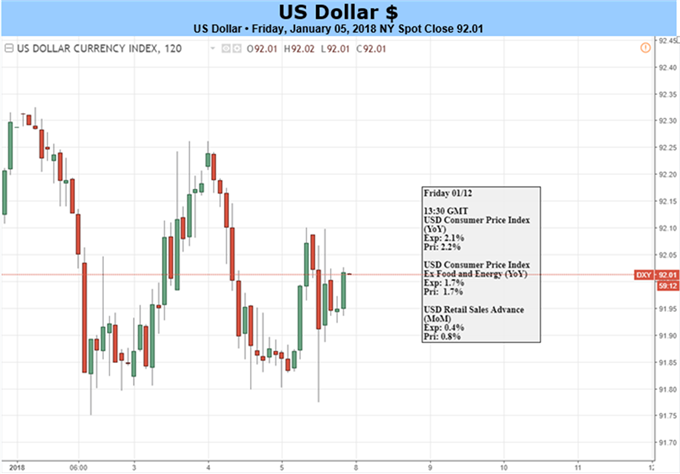
Talking Points:
- The market’s forecast for rates at year end via Fed Funds futures has hit its highest in a decade
- Monetary policy is losing its sway and political seems to be discounted, what themes remain?
- DXY is within sight of a 3-year low while EUR/USD hovers just off its historical range’s midpoint
Fundamental Forecast for Spot Gold: Neutral
The Dollar’s lack of traction through the opening week of the year was particularly palpable with benchmarks like the S&P 500 pushing relentlessly to a record high – and backed by the most robust pacing in nearly 13 months. With the lack of response to last week’s top event risk, FX traders are left to ask: what fundamental event risk or theme can still command the benchmark currency’s bearing and tempo? NFPs fell short of the consensus forecast, but the jobless rate held at a more than decade low while wage growth was steady at 2.5 percent. If fundamental traders were looking for a reason to mount a recovery from 2017’s slide, that would have been material enough. Alas, skepticism reigns and the Dollar’s gloom refuses to lift. An important qualifier to establish moving forward is whether traditional fundamental themes are still capable of charging speculative interests or if complacency is the primary environmental element which could significantly alter the way the market trades.
While this past week’s labor report was not particularly impressive in terms of sheer ‘surprise’ quotient relative to consensus forecasts, it certainly did not detract from the probability that the Federal Reserve would pursue a steady (but gradual) pace of tightening over the year. In fact, between the remarkably low unemployment rate and the fruitful wage growth, we found market-based rate forecasts extend a rise to levels not seen in a decade. Through the year’s end, Fed Fund futures project an implied rate of 1.94 percent. Relative to other central banks that are either maintaining their extremely easy policy accommodations or are actively expanding them, the US central bank is extraordinarily unique. Yet, that doesn’t translate into much lift nowadays. The hope of a 1.00 percent increase in yields 15 months down the line is drawing far less speculative interest than those speculative outlets that seems close to making the first step back from extreme accommodation. This robs the Dollar of its most potent motivator these past years and makes it more likely a source of burden than relief.
Yet, where the appetite for monetary policy speculation has shifted out of favor of the Dollar, it is unlikely to contribute to heavy selling any time soon. In the absence of this proactive theme, there are other matters that more readily present risk rather that promise. Markets are currently undeterred by the growing political risks, but the scandal in government and the threatening language between the US and North Korea can readily spur deeper concerns about investment USD-based assets. There is the off-chance that political headlines could inspire enthusiasm for funneling capital into US markets in the form of details for the promised infrastructure program, but that isn’t a spark one should simply wait for.
A lingering concern we should do well not to forget moving forward is the credit risk faced by US Treasuries – and by virtue of its fundamental connection, the Dollar – in the aftermath of the tax reform pashed by the US legislature and signed off by the President towards the end of last year. The tax plan drew forecasts for substantially increased debt levels for the United States over the next decade from nearly all non-partisan budget think tanks. That will not bode well for a country that has already received a downgrade from Standard & Poor’s (back in 2011) and is on credit watch negative across all the major agencies. If we were to experience a rate cut for US sovereign debt across the board, it would render a permanent downgrade to the Dollar’s value and increase for its resting rate of volatility. Watch for the intangible risks rather than the scheduled data this coming week.




